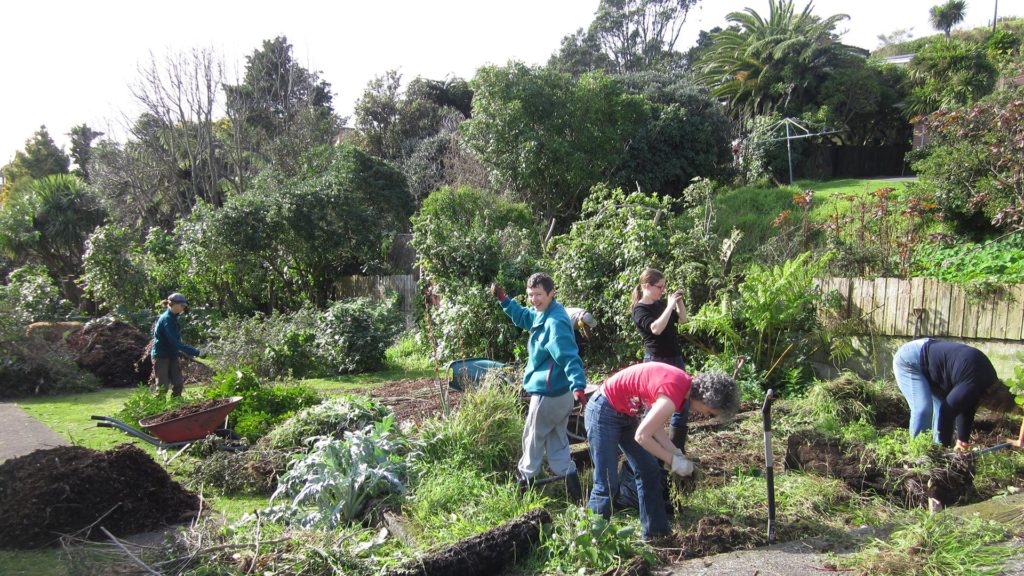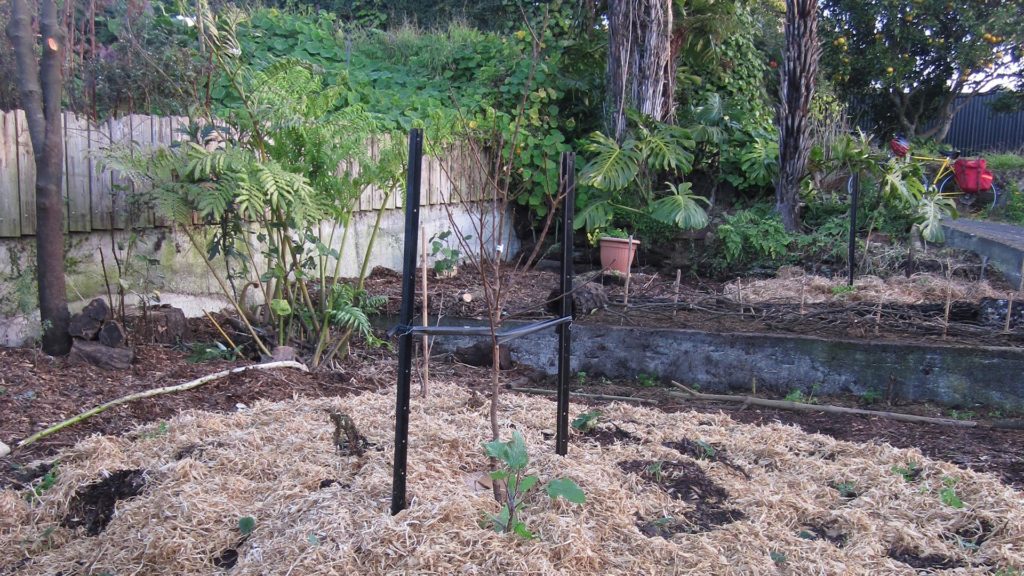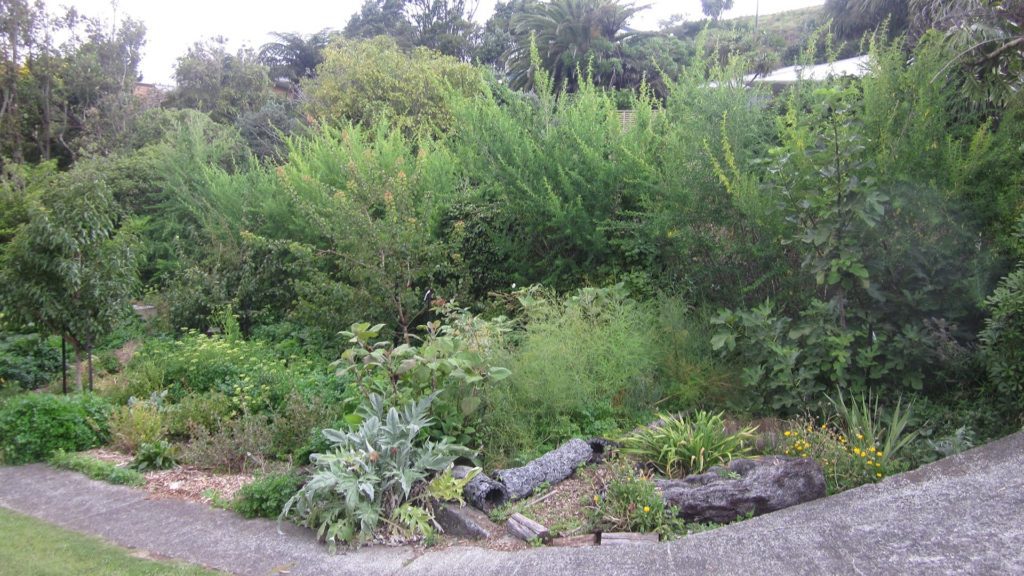Food Forest Case Study: Blagdon, Taranaki
This food forest was for a Greenbridge client who wished to establish an extensive urban food garden, making the site self-reliant for most fruit and vegetables, on her return to New Plymouth in three years’ time. The area designated for the food forest is 230sqm on the property’s south boundary, with a canopy of 5 fruit trees and a four-tier/layer system below. Microclimate and habitat suits deciduous pip and stone fruit trees and guilds….writes Bena Denton
SITE PROFILE
Location: Blagdon, New Plymouth
Size: 230sqm
Topography: gentle slope
Aspect/Solar Access: North-East facing (receives 8hrs sun during summer & 6hrs in winter)
Wind/Shelter: Somewhat sheltered from predominate Westerly and due to a hill to the South largely protected from damaging South Easterly (could do with increase to the south shelter).
Soil: Free draining loam, with existing moss and grass ground indicating slightly acidic soil.
Microclimate/Habitat: Reasonably sheltered warm site, which suits deciduous pip and stone fruit (if better shelter were present the microclimate would lean more toward sub-tropical).
Access: Good bike, foot & car access down a steep drive, which opens onto FF.
Water Management: A bit too free-draining due to a large terraced drop off to East (so mulching important for water retention). Hose/garden tap, currently from town supply, however, there are plans for a rainwater tank to be installed, which could syphon feed a barrel system in the FF.
SITE CHALLENGES
Weed’ issues abounded at this site; bindweed, climbing asparagus, tradescantia, balsum, caster oil plant, climbing fig, and oxalyis. While a weed is only a plant where you don’t want it and many ‘weeds’ are encouraged in a food forest (such as dandelion, chickweed etc.) for their edible and other uses, some weeds are pernicious and can make it difficult to grow the edible plants you may desire. Convolvulus or bindweed, in particular, posed a real problem, as this client is not in residence and if not checked will strangle fruit trees and ground covers would be hard to establish.
SITE ASSETS
Predominantly north-facing, free-draining site / Good Access (foot & driven) / Reasonably sheltered from predominant winds / Water Access (town supply and future rain tank) / Client with good gardening skills and permaculture understanding / A great install team!
INSTALL TEAM
Sorrel, Victoria, Susan (client), Barbara, Lou, Bena (GB), Dan (GB
PLANT/YIELD LAYER INCLUDED
5 x Canopy Fruit Trees:
1 x Apricot Fitzroy (on plum stock), prolific, local variety, $25-30
1 x Fig Brown Turkey (restricted) $60
1 x Peach Black Boy (on plum stock), does well some spots NP $25-30
1 x Plum Luisa (plum stock) Exceptional eating $25-30
1 x Plum Hawera (plum stock) local variety $25-30
The client selected the above varieties from a list, which also included: medler, persimmon, apple (low chill varieties) & pear (if espaliering).
12 x Soft Fruit/Bushes:
1 x Hazel Ennis (less vigorous but prolific), needs pollinator, prune 2m $12-15
1 x Hazel Whiteheart, pollinator $12-15
3 x Black Currant Goliath 1.5m large berries $5-6 each
3 x Black Currant Magnus 1.8m $5-6 each
2 x Gooseberry Invicta 1-1.5m $10 approx.
2 x Gooseberry Pax 1-1.5m $10 approx.
The client selected the above, from a list which also included: NZ cranberries, red currants, cape gooseberries, blueberries, cane fruit (if espaliering) & elderberry.
Many x Herbaceous Guilds/Perennial Ground Cover:
20 x Comfrey Russian clumping (mines potassium, 4 for each fruit tree) $2 each
5 x Spring Bulb packets (rot down at end of spring, when fruit trees need nutrients) $10 each
20-30 x Strawberry plants (good ground cover, spread by stolen) $2-3 each
10 x Oregano plants $2 each
Add any other perennial herb/veg/flowers readily available (i.e. kale, NZ spinach, borage, phacelia, lavender, thyme, yarrow, nettles, geranium, forget-me-nots, nasturtium, vetch, red clover, parsnip & violets etc.)
Perennial Beds:
For the narrow terraced beds that the footpath ‘circles’ around, suggested perennials were either; rhubarb, globe artichoke (one already growing there), cape gooseberry, asparagus & oca (yams).
Shelter
12 x Tagasasti $2 each
6 x Hebe small (or jerusalem artichoke) $5-7 each
Animals
Chooks (in future)
MATERIALS REQUIRED/USED
Straw: As weed free straw is expensive ($22/square bale), we used a mix of this and hay from our farmlet (using them in separate areas to test effect on weed growth). We found that ideally 1&1/2 large round bales are required for thick coverage of a 12sqm guild.
Compost: We brought in 1.5 cubic meters of compost (allowing for approx. 2/10 of a cube per fruit tree and some for the berry bushes). Purchased from Return2Earth who do compost, which is not organic, but good quality. 1 cube is $120 + $50 delivery ($230 total)
Stakes: Long un-tanalized wooden stakes are hard to source, so we used 1.8m high Steel-Y-Post (warratah), which gave us the advantage of not breaking in wind, not rotting and being able to be reused). Two needed per tree. Purchased from RD1 at $10.90 each ($109 total)
Fertilizers/Maintenance: In addition to the living mulches and plant miners (tagasaste/ comfrey…), horse poo, carbon mulch (cardboard and straw), compost, potash/lime were all added to any dug over soil (to raise PH). The FF would benefit from seaweed meal (esp. asparagus in spring) and all fruit trees could do with a foliar spray of seaweed (the peach may need a copper spray at bud burst if the leaves are showing signs of cull-leaf fungus).
Further Materials: Pruning Wax / Bark for path mulch (on site from previous arborist work) / Newspaper and/or Cardboard / Plastic Bottle cloche (for tender veg) / Inner Bike Tubes (from bicycle shop – for fruit trees ties) / Wood Ash (for liming, saved from wood burner) / Plastic Bin (for Fig root restriction – drill drainage holes before burying).
TOOLS
Planting Spade(s) / Shovels / Trowels / Garden Fork(s) / Garden Buckets (plastic flexi 2-3) / Secateurs (sharp) / Pruning Saw Loppers / NT Cutter / Wheelbarrow 2-3 / Hammer / String Line / Chainsaw / Axe (for cutting roots) / Contractors Long Bar / Bamboo or other making pegs (two types min) / Gloves / Protective eyewear and Ear muffs / Baby Sledge / Hacksaw / Pliers / Adjustable Crescent / Screw drivers / Power Drill / Hose.
ORDER OF WORKS
- Cleared scrub and mulched it
- Moved mulch (was situated on FF site)
- Marked out (placement of; fruit trees, berry bushes, shelter plants, paths/access
- Dug holes (for tree planting)
- Planted & watered trees & shrubs
- Mulched plantings (layered cardboard, green mulch from site clearing, topped with straw and wet thoroughly with hose)
- Staked trees
- Pruned fruit trees (in fine weather & wax cuts)
- Laid Cardboard (on remaining bare ground)
- Bark mulched paths
- Plant guilds/ground covers
- Water all plantings well.
For more detail on the permablitz process we followed, check out our blog greenbridge.co.nz
LABOUR
Seven people for 1.5 days to install all three tiers in one go. (2 days needed if we had dug over all of planting area and planted all perennials).
COST
Plants approx. $330 / Materials approx. $370 / Labour free / Food for team $50 – Total $750
Things That Worked Well:
- Having clear well thought through plan, that considered both the specific FF and also the overall site within its design.
- Having a cuppa with the install team before starting – debriefing and getting everyone on the same page, knowing the order of works and getting to know each other.
- A client/ owner that understood and is committed to the objectives of the project.
- Have a good team of people that have a reasonable gardening knowledge.
- Have one person in charge overseeing the vision if possible – not every one can picture the end result, so someone needs to be making decisions based on a well thought through plan.
- Clear the site thoroughly before marking out – with a clean slate the site looks different (usually larger) and makes marking our easier.
- Marking out paths, major plantings etc early to give a sense of design on site (and allow for adjustments).
- Invest in good metal stakes – they will last forever and can be reused.
Things That Didn’t Work Well:
- Pay more attention to designing in utility spaces (its not just about the food, but infrastructure too).
- Needed a lot more straw than first anticipated 1.5-2 bales per 12sqm guild.
- Plant more berry bushes – I was wanting to minimise cost for the client and specified too few, which is a lost opportunity as these will produce quicker than the fruit trees.
- Calculating the number of perennial ground cover is tricky (could be up to 200 plants per 12sqm if they have a small mature diameter), we want weed suppression but not the expense of buying too many plants…
- We ran out of time, so didn’t dig over all the garden – this made planting the perennials harder later
Top Tips for a Putting in a Good Food Forest in NP
- Let your pencil and paper do the leg work – plan it out on paper prior to any digging.
- Know your habitat and microclimate; what are your neighbours growing well? Talk to nursery people, what heritage varieties can you cultivate?
- Take the time to remove ‘weeds’ prior to laying down cardboard.
- If you have the time, grow heaps of perennial ground cover plants (taking cuttings, splitting, propagating a year in advance etc.).
- Make huge composts 3-6 months in advance (its expensive to buy in).
- If possible, solarise the area for 6-8 months prior to planting, so that the soil is conditioned (making it easier to dig over come planting time).
- Collect up materials well in advance (heaps more cardboard than you think you will need), visit farms and collect poo (let it age if mixing with soil in fruit tree holes), fresh is fine to top dress, wood ash from the fireplace…
- Get your head around succession – time, the fourth dimension – what will your FF look like when first planted, in three years time and once mature 5-10+ years? Some plants will go in now, produce well then be shaded out or be sacrificial…
- Have good edging for paths sorted (this particular client wanted a ‘loose’ feel to the FF and no edging, however for establishment purposes, well marked paths make access, planting and maintenance so much easier.
- Stay calm and be well prepared!




